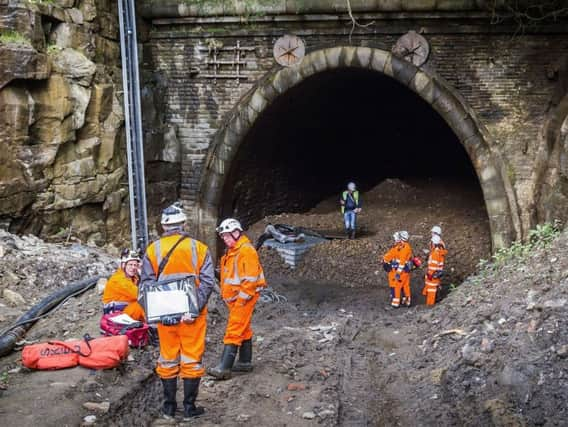Floods reaching 11 foot delay work on Queensbury tunnel


On Monday, AMCO-Giffen, the appointed contractor, was intending to begin the installation of temporary strengthening arches in Queensbury Tunnel - between Bradford and Halifax - but access at the south end was impossible due to water extending more than 350 yards into the tunnel.
Advertisement
Hide AdAdvertisement
Hide AdAlthough the north end - which is 75 feet higher - remained dry, workers entering there would have had no second escape route in the event of an emergency evacuation.
The Queensbury Tunnel Society said the situation arose due to the loss of a lease which had been secured in 2015 to allow the construction and operation of a pumping station.
The society says the £50 annual rent had not been paid for two years and the Department for Transport (DfT), which owns the tunnel, did not respond to a notice of forfeiture.
Advertisement
Hide AdAdvertisement
Hide AdNorah McWilliam, leader of the Queensbury Tunnel Society, said: “The lease came at a cost of several hundred thousand pounds in legal action and was vital to Highways England in order to deliver its questionable £3.6 million abandonment scheme. The profound consequences of the £50 rent being overlooked are now becoming clear.
“But this is an opportunity for them to pause and reflect. Bradford Council is looking at the viability of taking on the tunnel’s ownership, allowing it to be transformed into a nationally significant landmark on our cycle path network which would bring benefits to the region for generations to come. That process should be allowed to run its course without the threat of abandonment overtaking it.”
It is understood that Highways England is now progressing the option of pumping the water to the north end of the tunnel, a distance of 1.4 miles.
To do so, pipes and equipment would have to be taken through a 330-yard long section of tunnel which has been designated as an exclusion zone due to two partial collapses of the lining, obstructing the passageway.
Advertisement
Hide AdAdvertisement
Hide AdGraeme Bickerdike, the Society’s Engineering Co-ordinator, said: “It would be extraordinary if Highways England went down this road before they’ve had sensible discussions with the landowner about a new agreement to re-establish the existing water management arrangements.
“Creating a safe access route through the collapses and putting a more powerful pumping system in place would be technically demanding and add considerable cost, although Highways England seems to habitually forget that it’s spending public money. But more importantly, this approach would needlessly expose the workforce to much higher levels of risk. Why would they do that when there’s a cheaper, simpler and safer alternative?”
Following two weeks of on-site investigations over the summer, Bradford Council is shortly expected to receive a report from its consulting engineers on the condition of Queensbury Tunnel and the likely cost of bringing it back into use.
The findings will be reviewed alongside other relevant issues before a decision is taken on a transfer of the tunnel’s ownership to the Council, without which the proposal to reopen it as a cycle path cannot move forward.